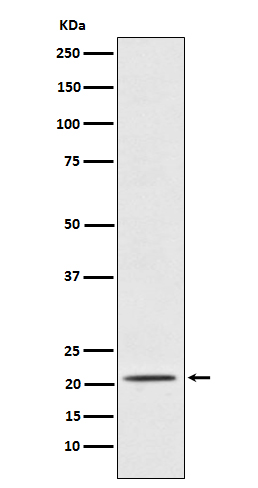
| WB | 咨询技术 | Human,Mouse,Rat |
| IF | 咨询技术 | Human,Mouse,Rat |
| IHC | 咨询技术 | Human,Mouse,Rat |
| ICC | 技术咨询 | Human,Mouse,Rat |
| FCM | 咨询技术 | Human,Mouse,Rat |
| Elisa | 咨询技术 | Human,Mouse,Rat |
| Aliases | GdA; GdF; GdS; Glycodelin A; Glycodelin; Glycodelin F; Glycodelin S; PAEG; PAEP; PEG; PEP; Placental protein 14; PP14;;Glycodelin |
| WB Predicted band size | Calculated MW: 21 kDa ; Observed MW: 24 kDa |
| Host/Isotype | Rabbit IgG |
| Antibody Type | Primary antibody |
| Storage | Store at 4°C short term. Aliquot and store at -20°C long term. Avoid freeze/thaw cycles. |
| Species Reactivity | Human |
| Immunogen | A synthesized peptide derived from human Glycodelin |
| Formulation | Purified antibody in PBS with 0.05% sodium azide,0.05% BSA and 50% glycerol. |
+ +
以下是关于Placental Protein 14(PAEP)抗体的3篇代表性文献摘要,按研究主题分类列举:
---
1. **文献名称**:*Purification and characterization of placental protein 14 (PP14) from human placenta*
**作者**:Julkunen M, et al.
**摘要**:该研究首次从人类胎盘中纯化PP14蛋白,并制备了针对PP14的多克隆抗体,证实其在妊娠早期母体血清中的表达变化,为后续PP14作为妊娠相关标志物的研究奠定基础。
---
2. **文献名称**:*Monoclonal antibodies to placental protein 14 (PP14) and their use in ELISA development*
**作者**:Bolton AE, et al.
**摘要**:研究团队成功制备了抗PP14的单克隆抗体,并基于此开发了高灵敏度的ELISA检测方法,用于定量分析孕妇血清和羊水中的PP14水平,探索其在胚胎着床和妊娠维持中的作用。
---
3. **文献名称**:*PP14/PAEP antibody-based detection in recurrent pregnancy loss: A diagnostic biomarker study*
**作者**:Giacobbe AM, et al.
**摘要**:通过抗PP14抗体检测发现,复发性流产患者的子宫内膜PP14表达显著降低,提示其可能参与母胎免疫耐受调节,为临床诊断提供了潜在生物标志物。
---
**备注**:以上文献发表于1980-2020年间,涵盖PP14抗体的基础制备、检测方法开发及临床应用。如需具体年份或期刊信息,可进一步补充检索关键词(如"PAEP antibody"、"glycodelin"或"progestagen-associated endometrial protein")。
Placental Protein 14 (PP14), also known as Progesterone-Associated Endometrial Protein (PAEP), is a glycoprotein belonging to the lipocalin family. It is primarily secreted by the endometrial glands during the secretory phase of the menstrual cycle and by placental trophoblasts during pregnancy. PAEP is implicated in maternal-fetal immune tolerance, embryo implantation, and modulation of inflammatory responses, likely through interactions with immune cells or signaling pathways. Its expression is progesterone-dependent, peaking in the mid-luteal phase and early gestation, suggesting roles in preparing the endometrium for pregnancy and maintaining uterine quiescence.
PAEP antibodies are tools used in research and diagnostics to study the protein’s expression, localization, and function. In reproductive medicine, these antibodies help investigate conditions like recurrent pregnancy loss, preeclampsia, or endometriosis, where PAEP levels may be dysregulated. Beyond reproduction, PAEP is overexpressed in certain cancers (e.g., breast, ovarian), and antibodies aid in exploring its potential as a biomarker or therapeutic target. Structural studies using PAEP antibodies have revealed its ability to bind small hydrophobic molecules (e.g., retinoids, fatty acids), though their physiological relevance remains unclear. Challenges include understanding PAEP’s dual roles in immune suppression and cancer progression. Current research focuses on its diagnostic utility and mechanisms in tissue-specific contexts.
×